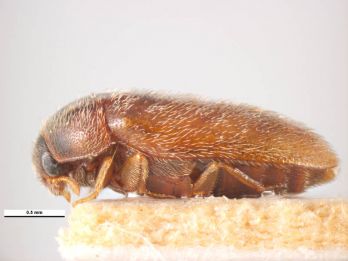Khapra beetle
Khapra beetle (Trogoderma granarium) is not present in Australia and poses a major threat to our grains, dried fruit, and nut industries.
Background
Khapra beetle affects parts of Asia, Africa, the Middle East and Europe. It prefers hot, dry conditions and is often found in:
- grain and food stores
- malt houses
- seed processing plants
- fodder production plants
- dried milk factories
- shipping containers and warehouses
- stores of packing materials (used or unused sacks, bags, crates and linen)
- kitchen pantries.
Khapra beetles are thermophilic, but they can also lapse into a state of rest or torpor (diapause) to survive unfavourable conditions. It will not usually be present outdoors or in damp areas.
These beetles cannot fly and spread mainly by commerce and trade. They are transported in shipments of agricultural or canned products, rubber and clothing. Khapra beetle also spreads through movement of grains or as contamination of seed, machinery and straw.
Impacts
Khapra beetles are a serious pest of stored grain and dry foodstuffs worldwide. This insect is by nature an omnivorous protein scavenger and can cause losses of up to 75% from direct feeding.
The adult beetles do not feed, but the larvae have a broad nutritional spectrum and are voracious eaters. They target:
- grains and seeds
- processed vegetables and animal products
- spices and herbs
- nuts
- dried fruits.
Infested grain also becomes contaminated with beetles, cast skins and hairs from larvae, which can be a health risk and are difficult to remove from storage structures and transport vessels.
Identification
Khapra beetle is almost identical to many species of beetle native to Australia, such as warehouse, carpet and hide beetle. Only microscopic examination can identify them.
Adult beetles are dark brown and have pale yellow and reddish-brown bands across the wing cases. They are oval in shape, and about 2 to 3mm long. Khapra beetles are covered in fine hairs that can rub off, leaving the beetle shiny in appearance.
Females are larger than males and lay 50 to 100 eggs a time, which can produce up to 9 generations a year.
Larvae are pale yellow when small and become golden brown when they grow. They range in size from 1.6 to 5mm long. Larvae are hairy, forming distinctive tufts over the body and a group of setae emerge from the posterior end.
Khapra beetles go through up to 9 moulting stages, leaving behind numerous cast skins.


